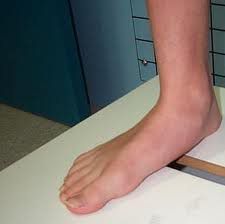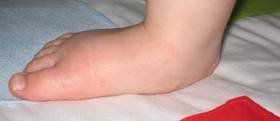Flat feet, also known as fallen arches are often viewed as problematic simply because they look abnormal – the main arch of the foot, the medial longitudinal arch, has collapsed. Though flat feet are by no means normal, they are often the result of some other underlying condition or weakness rather than a problem with the actual arch itself that has collapsed. Conventional treatment involving foot support either via supportive footwear, orthotics, or some other bracing system is usually more disadvantageous than beneficial and surgery is rarely the answer.
Different Types of Flat Feet

A normal foot has an apparent arch while non-weigh bearing (sitting, lying) and also when they are weight bearing (standing, walking, running). There are two types of flat feet, rigid flat feet (RFF) and flexible flat feet (FFF).
An individual with RFF has no arch at any time – weigh or non-weight bearing. RFF is usually caused by some underlying pathology. A condition called tarsal coalition is the most common reason for RFF and occurs when two or more of the seven tarsal (foot) bones fuse together. Trauma, infection, and neuromuscular and autoimmune disorders (such as Rheumatoid Arthritis) can also result in RFF.
An individual with an arch non-weight bearing which fatigues or collapses when they stand or the foot is stressed is said to have FFF. FFF is most often due to ligament laxity (the ligaments connecting the bones together have weakened) or due to muscle or tendon weakness. The tibialis posterior muscle has a major impact on the medial longitudinal arch as it provides much of its support. Therefore, a problem with this muscle can result in FFF as well as other problems associated with tibialis posterior dysfunction – shin splints, plantar fasciitis, and injuries associated with overpronation.
Development of a Normal Foot and Gait

Flat feet are normal in a toddler; as they get older the tendons in the foot strengthen and tighten to form the medial longitudinal arch, often by the age of three to six. Some never fully develop this arch in the foot, most often due to poor footwear, so they develop FFF. A childhood disease or injury could result in RFF.
A natural gait then develops in a child once they being to walk, and then run. If the child is left to move barefoot or in moccasin-type unsupportive footwear their gait will not be disrupted by external means. When they walk they will quietly land and roll off their foot and when they run they will naturally land mid or forefoot, efficiently dispersing shock and generating power, strength, and balance.
A child who moves with modern-day shoes or braces (orthotics) will always alter their gait abnormally. It is very awkward for them and their proprioception (body position) and kinesthetic sense (nervous system response to “feeling” the ground) are hindered. Ligament laxity and tibialis posterior muscle weakness can and does often occur resulting in FFF.
As you can see, optimum foot development occurs barefoot.
Shoes and Orthotics Negatively Affect the Foot
I always chuckle when I hear the terms corrective shoes or corrective, functional orthotics. These are misnomers – they provide support of the dysfunction, never any correction. I won’t discuss the major pitfalls with either as there is plenty of information on the Sock Doc site regarding the use of orthotics and the benefits of barefoot and minimalist-type footwear.
There are studies and clinical evidence showing that treating FFF with orthotics doesn’t change the course of arch development. Actually, though strengthening the entire foot and lower leg is important for the health and fitness of everybody and especially a person with flat feet, the arch may not change significantly if there are anatomical changes that have occurred during development. In other words, it may be too late (the person may be too old) to see FFF regain its weight-bearing arch. However, this should not be of concern as there is no correlation between an arch height and injury, pain, or performance.
In 2009 Pediatrics published a study of 218 kids aged 11 to 15 and found “no disadvantages in sport performance originating from flat feet”. The kids who had flat feet accomplished all 17 motor skills as well as the group with normal feet.
Another study of 246 US Army recruits found that trainees with low or flat arches actually had a lower risk of injury than those trainees with high arches during their 12-week infantry training.
So although one would not want to just ignore their FFF, or especially their child’s FFF, it shouldn’t be any cause for alarm, and especially no reason to wear supportive shoes or an orthotic – either will simply make the problem worse. Orthotics and arch supports that are used to treat flat feet and fallen arches don’t support the arch of the foot where it actually needs to be supported. To properly support any arch, from a bridge over water to the arch of the foot, either end of the open space should be supported. In the case of the foot, the heel and the forefoot should be supported, not the space in-between the ends of the arch. These devices only promote more weakness and dysfunction and DO NOT change the course of arch development.
Natural Prevention and Treatment of Flat Feet
Though most FFF are asymptomatic (no pain or discomfort), they should still be addressed as it is not normal to have flat feet. Obviously it is always ideal to prevent a problem rather than treat it after it occurs, especially if FFF is being treated post-foot development. As mentioned earlier, barefoot is the best way to prevent FFF and a host of other foot and gait imbalances. To truly strengthen the entire foot and all the arches, it’s important to position the foot correctly at all times so when wearing something on the feet, footwear should be flat, firm, and flexible. This means that the shoe should not have a significant, or any, heel to toe drop, there should be little to no cushion or padding in the sole, and the shoe should not be rigid anywhere – it should bend throughout the shoe and in any direction. The shoe should also be wide at the toe box allowing the toes to naturally splay apart.
Standing and walking barefoot are two easy ways to start treating flat feet naturally. Balancing on one leg and light jumping while barefoot will further progress the normal development of the foot; and finally running while barefoot is the ultimate way to naturally and most effectively strengthen the muscles, tendons, and ligaments of the lower leg and foot. Of course a child running barefoot is much less likely to have FFF than a shod child.
Sometimes other interventions and therapies are needed for flat feet. In the case of RFF, which is much less common than FFF, treating the cause of the problem is recommended. If the RFF is causing problems (such as pain) then in some cases, depending on the individual, surgery or a supportive orthotic may be beneficial. Trigger point work and other therapies can also be very beneficial for RFF and especially FFF to help in the rehabilitation of the supporting structures of the foot. The tibialis posterior muscle is the muscle I most often have to treat for flat feet due its importance with arch support. Check out the Sock Doc video on Plantar Fasciitis for more information on how to find and treat trigger points for this muscle, as well as more information as to why the tibialis posterior can fatigue aside from improper footwear or gait mechanics.
